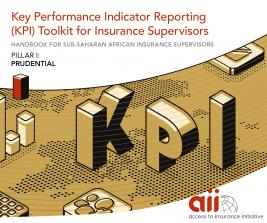New blog post: InsurTech – shaping financial services in Sub-Saharan Africa
by Pascale Lamb, A2ii and Tom Herbstein, UK’s Department for International Trade (DIT)
Delivering financial inclusion is a core principle of the Sustainable Development Goals (SDGs) given its role in eradicating poverty. Africa is particularly impacted, given that half of the population is without access to formal financial services. Access to bank accounts hovers at 40%, while insurance accounts for just 3% of GDP, against a global average of 7%.
However, recent technological developments have led to the financial system becoming more accessible to low-income populations than ever before. Across Sub-Saharan Africa, for example, the growth of mobile penetration rates has risen to over 43%, providing a crucial platform for the digital expansion of financial services.
For its part, InsurTech is emerging as a major force shaping the structure of financial services across Sub-Saharan Africa. New technologies are being developed and implemented that are changing the competitive landscape, challenging traditional structures, and significantly improving access to insurance. While this creates new challenges, Insurtech is emerging as an enabler by improving financial inclusion and facilitating innovation across other sectors, like agriculture.
Covid-19 is catalysing innovation
Virtually no sector has proven to be immune to Covid-19. For InsurTech, while it has always been touted as the ultimate disruptor of insurance, the pandemic has also risked becoming the ultimate disruptor for InsurTech itself.
Behind this growth remains the challenge that serving low-income and vulnerable customers may not be as cost-effective when using traditional insurance approaches and that this innovation is required to break into this underserved, yet growing market.
However, during the A2ii’s recent Sub-Saharan Africa Public Dialogue on InsurTech, the conclusion was that if anything the pandemic has accelerated digitalisation, rather than inhibited it. Findings shared by the Cambridge Centre for Alternative Finance (CCAF), from their global Covid-19 Fintech Regulatory survey, found that during the pandemic InsurTechs across Sub-Saharan Africa recorded 19% growth in customers, 6% increase in transactions and 40% of firms indicating the launch of new Covid-19 products. Behind this growth remains the challenge that serving low-income and vulnerable customers may not be as cost-effective when using traditional insurance approaches and that this innovation is required to break into this underserved, yet growing market.
Few sectors across Africa are as vulnerable as agricultural. Be it weather, pests or crop diseases – farmers are at the mercy of nature. CEO and co-Founder of Kenyan AgriTech, Pula, Thomas Njeru, outlined how the service provider supports agricultural resilience by providing crop insurance to 3.5 million African farmers. Pula bundles partners with distributors to package insurance into agricultural inputs; including fertiliser, seeds, or credit. Using parametric insurance, climatic triggers result in farmers receiving a voucher for replacement seeds—a simple product with effective results.
It’s not just InsurTechs making use of digital, but incumbents too. Achumile Majija, from Prudential Africa, outlined how, as an incumbent “either you adapt, or you fail”. Prudential Africa has been using technology to improve its distribution channels. It recently launched a mobile app linking customers directly to underwriters. The incentive is partly driven by the pandemic but also growing realisation around shifts in consumer behaviour resulting in a move online and increased expectations regarding the processing of sales and claims.
However, it’s not simply enough for insurers to innovate. Supervisors and regulators must also embrace and facilitate this digital revolution.
Regulatory approaches a key driver/inhibitor of innovation
Supervisors are key in bringing the potential benefits of technology to fruition. However, embracing InsurTech should also not lead them to ignore the risks of innovation. Pula highlighted how their business model, with four different licenses, led to supervisors often struggling to classify them as a ‘service provider’ or a non-traditional entity. Should they be treated as a claim’s adjuster? A reinsurance broker? Or an insurer?
In practice, a variety of approaches must be taken and, to varying degrees, supervisors are striving to achieve a balance via a variety of regulatory tools. Of this is being driven by regulatory mandates that have expanded over recent years to include market development, alongside consumer protection and financial stability. Both Uganda and Kenya now have explicit market development mandates -which has been key for embedding digital into their regulatory approaches.
Insurance regulators are also exploring regulatory sandboxes, borrowed from the banking sector. Sandboxes create a safe space for innovators to test products whilst ensuring a high level of consumer protection. They also facilitate dialogue between regulators and innovators and are key in establishing new, innovative digital ecosystems.
Open Dialogue & Mindsets a low-hanging fruit
However, during the panel discussion on regulating for innovation, Cenfri highlighted that supervisors can still accommodate innovation without the cost and complications associated with formal regulatory sandboxes.
Kofi Andoh, Deputy Commissioner of Insurance at the National Insurance Commission of Ghana, reinforced this by reflecting that while risks for regulators are undoubtedly changing due to digitalisation, “supervisors should not build walls but instead walk side by side and try and understand”. CCAF reinforced this view, explaining that a supervisor being open to innovation by enabling dialogue with innovators can be equally effective as a formal sandbox. It sends a strong signal to innovators and, practically, helps to clarify how innovation fits into the existing regulatory framework or may expose regulatory barriers supervisors were not yet aware of.
Finally, supervisors must also build their capacity and understanding of the risks. This can only be achieved by developing their knowledge of the underlying technology. It’s not just the mindsets of regulators that InsurTechs must win over, they must also focus on the ultimate prize – the end consumer. While consumers are increasingly moving online and may initially appear to be open to new entrants, brand recognition, trust, and “human touch” remain vitally important. There is no consumer appetite or room for failure, presenting a challenge that both InsurTechs and supervisors must manage.
The combination of the changing environment and the shift in consumer behaviours and expectations has the potential to drive unprecedented change.
None of these challenges is new for either InsurTechs or supervisors. Nor do they stem from the pandemic. The insurance industry continues to evolve, and InsurTech plays an increasingly important and vital role in fostering financial inclusion. However, the pandemic has accelerated some of these trends and intensified the need for the industry to adapt to a rapidly changing environment. The combination of the changing environment and the shift in consumer behaviours and expectations has the potential to drive unprecedented change.
The outlook for InsurTech, therefore, remains promising and is opening up new opportunities to accelerate progress. Regulators and supervisors will need to stay alert to support innovation, and in turn create greater access to insurance, while closely monitoring new vulnerabilities that may arise.










